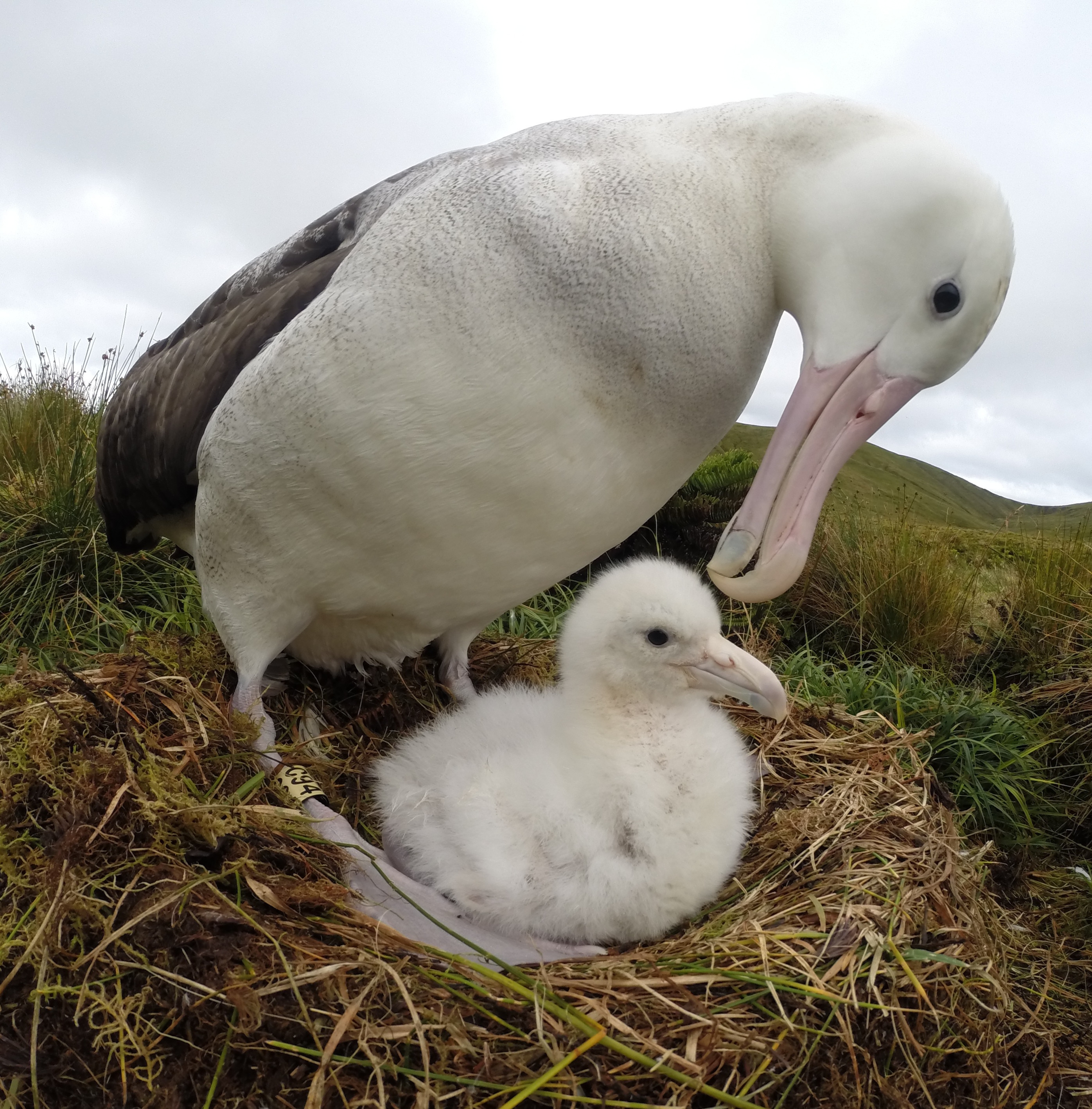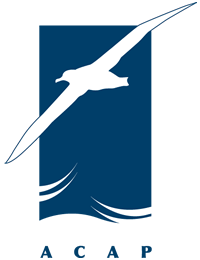Birds, including ACAP-listed seabirds, under study are regularly banded (= ringed) on their legs with metal bands bearing uniquely engraved numbers that identify the individual, along with an abbreviated reporting address. Metal bands are hard wearing and are designed to last the lifetime of the bird. For subsequent identification in the field without the need for handling, birds may also carry a plastic band identified by background colour and engraved "alphanumeric " (letter and number) combination, such as the pictured Tristan Albatross Yellow C94 below. Alternatively, in addition to a metal band, birds may carry two or more plain plastic bands of different colours on one or both legs that in combination are unique to the individual in the population studied.

A colour-banded Critically Endangered Tristan Albatross Diomedea dabbenena guards its downy chick in the Gonydale monitoring colony on Gough Island, photograph by Michelle Risi
Seabirds that die at sea may be washed ashore onto beaches far from their breeding sites (or come ashore ill or exhausted to die or be collected and then taken alive to rehabilitation centres for treatment). If on discovery and inspection by members of the public they are seen to be carrying leg bands (click here for an example), the full details engraved on their metal bands and information of colour bands if present, should be reported, along with finding location and date, and if possible photographs, to the relevant national banding scheme. Much the same applies to reporting banded birds caught at sea as part of fishing operations. Banded seabirds that come aboard fishing vessels alive should be released following recommended procedures after recording the band information (but without removing the bands).
A list of banding schemes in countries known to band ACAP-listed albatrosses, petrels and shearwaters follows.
Bands should never be removed from live birds. No financial reward is offered for returning bird bands.
Australian Bird and Bat Banding Scheme (ABBBS)
GPO Box 8, Canberra ACT 2601, AUSTRALIA
Tel: + 61 2 6274 2407
Fax: +61 2 6274 2455
Email:
http://environment.gov.au/science/bird-and-bat-banding
New Zealand - NZ National Banding Scheme
National Banding Office, PO Box 108, Wellington 6140, NEW ZEALAND
Tel: +64 4 471 3248
Email:
osnz.org.nz/nz-national-banding-scheme
Japan - Yamashina Institute for Ornithology
Yamashina Institute for Ornithology, Bird Migration Research Center, 115 Konoyama, Abiko, Chiba, 270-1145, JAPAN
Tel :+81-4-7182-1107
Fax: +81-4-7182-4342
Email:
http://www.yamashina.or.jp/hp/english/banding/birds_rings.html#br07
France - Museum National D’Histoire Naturelle
Muséum National d’Histoire Naturelle, Centre de Recherches sur la Biologie des Populations d’Oiseaux, 55 rue Buffon, 75005 Paris, FRANCE
Tel: +33 1 40 79 30 78
Email:
https://crbpo.mnhn.fr/
For all albatrosses, giant petrels and Procellaria petrels with metal bands inscribed OIS MUSEUM PARIS also contact:
Henri Weimerskirch / Dominique Besson
CNRS CEBC, 79360 Villiers en Bois, FRANCE
Email:
Spain - Oficina de Especies Migratorias
Sociedad Española de Ornitología, SEO/BirdLife, C/ Melquiades Biencinto, 34, 28053 Madrid, SPAIN
Tel. +34 91 434 09 10
Fax. +34 91 434 09 11
Email:
http://5.56.57.39/main.aspx
United Kingdom - British Trust for Ornithology
Including metal bands inscribed “NH Museum, London SW7”
British Trust for Ornithology (BTO), The Nunnery, Thetford, Norfolk IP24 2 PU, UK
Tel: +44 1842 750050
Fax: +44 1842 750030
https://app.bto.org/euring/lang/pages/rings.jsp
Metal bands:
Colour bands:
or find colour band project leaders directly: http://www.cr-birding.org/colourprojects
South African Bird Ringing Unit (SAFRING)
SAFRING, FitzPatrick Institute of African Ornithology, Rondebosch 7701, SOUTH AFRICA
Tel: +21 650-3305
Email:
http://safring.birdmap.africa/
USA - The North American Bird Banding Program
Bird Banding Laboratory; USGS Patuxent Wildlife Research Center, 12100 Beech Forest Road, Laurel MD 20708-4037, USA
Toll free tel: 1-800-327-2263
Email:
https://www.pwrc.usgs.gov/BBL/bblretrv/
Argentina - Centro Nacional de Anillado de Aves (CENAA)
Centro Nacional de Anillado de Aves (CENAA), Facultad Nacional de Ciencias Naturales y Fundación Miguel Lillo, Miguel Lillo 251. T4000JFE - San Miguel de Tucumán, Tucumán - ARGENTINA
Tel: +54 0381.451.8497/0381 – 423.9456 – 433.0633 (ext. 212)
https://www.anilladores.com/
Brazil - Sistema Nacional de Anilhamento (SNA)
Centro Nacional de Pesquisa e Conservação de Aves Silvestres (CEMAVE), BR 230 - KM 10, Floresta Nacional da Restinga de Cabedelo, Renascer, 58.108-012 - Cabedelo – PB, BRAZIL
Tel. 83 3245-5001
Email:
https://www.icmbio.gov.br/cemave/
Chile - Sistema Nacional de Anillamiento de Aves Silvestres (SNAA)
Servicio Agrícola y Ganadero (SAG), División Protección Recursos Naturales Renovables, Departamento Vida Silvestre, Bulnes 197, piso 5, Santiago de Chile, CHILE
Teléfono: +56 2 6714081
Email:
https://snaa.sag.gob.cl/
Ecuador (Galapagos) - Charles Darwin Research Station
https://www.darwinfoundation.org/en/
https://www.facebook.com/watch/?v=315746545784281
NOTE: Mexico does not have a national banding scheme

 English
English  Français
Français  Español
Español